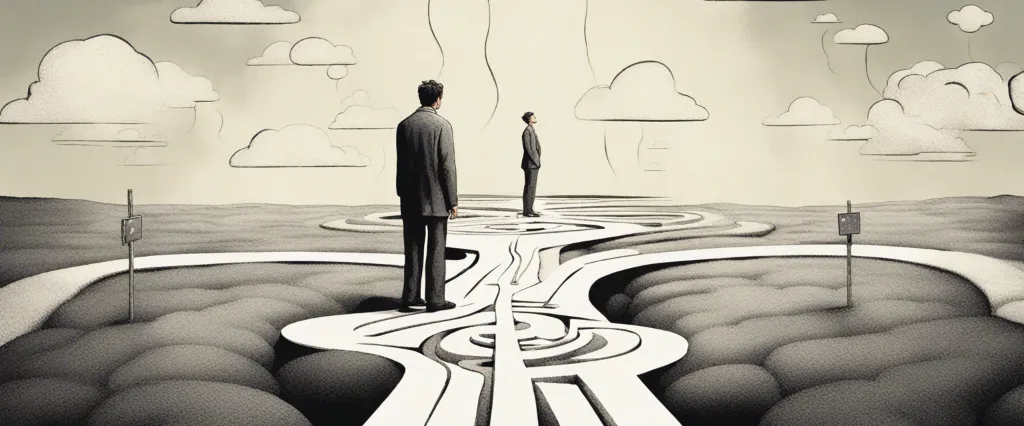In his thought-provoking book, “The Upside of Irrationality,” renowned behavioral economist Dan Ariely challenges conventional wisdom and explores the fascinating realm of human irrationality. Drawing upon numerous enlightening experiments and real-life examples, Ariely reveals the surprising ways in which our irrational behaviors often yield unexpected benefits. With his unique blend of humor, intelligence, and insights, Ariely presents a captivating exploration into the contradictory world of human decision-making. As a highly esteemed professor of psychology and behavioral economics at Duke University, Ariely has dedicated his career to unraveling the complex mysteries of human behavior and helping us understand how we engage with the world in ways that defy logic and reason.
Chapter 1: The Irrationality of Expectations
Chapter 1 of The Upside of Irrationality by Dan Ariely introduces the concept of irrationality in human expectations. Ariely explores the various ways in which our expectations often deviate from rationality and how these deviations influence our behavior and decision-making.
The chapter begins with a personal anecdote about Ariely’s triumph over a debilitating injury. He expected that upon recovery, he would be ecstatically happy, but found that reality fell short of his inflated expectations. This experience led him to question why our expectations often fail to align with reality.
Ariely highlights three main factors that contribute to irrational expectations. First, he discusses our tendency to reference external anchors rather than internal standards when making judgments. Our expectations are often influenced by comparisons to others or should-be scenarios, rather than objective evaluations. Furthermore, our expectations are governed by the immediate context in which they are formed, making them easily swayed by external influences.
Secondly, Ariely introduces the concept of adaptation. Humans have remarkable adaptive capabilities, which enable us to adapt to different circumstances and normalize them over time. However, this also means that we are seldom satisfied with the status quo, constantly seeking novelty and progression. These adaptive qualities lead to continuously shifting expectations that rarely keep pace with reality.
Lastly, Ariely explores the impact of social comparisons on our expectations. We tend to judge our own happiness and success relative to others, often leading to unrealistic and unattainable expectations. This can result in a perpetual cycle of disappointment and discontentment.
In conclusion, Chapter 1 of “The Upside of Irrationality” sets the foundation for understanding the irrational nature of human expectations. It reveals the factors that steer our expectations away from rationality, highlighting how external anchors, adaptation, and social comparisons shape our perceptions of reality. Through this exploration, Ariely lays the groundwork for addressing the upside of irrationality and its potential benefits.
Chapter 2: The High Price of Ownership
Chapter 2 of “The Upside of Irrationality” by Dan Ariely, titled “The High Price of Ownership,” explores the concept of ownership and how our attachment to possessions influences our decisions and behaviors in irrational ways. Ariely presents various experiments and real-life examples to illustrate the impact of ownership on our perception of value and the choices we make.
The chapter begins with an experiment involving ticket resale markets. Ariely conducted a study where participants were randomly assigned tickets to a basketball game. Some participants were given the opportunity to sell their tickets on a resale market, while others were assigned to keep their tickets. The results showed that those who acquired tickets with the option to sell asked for a significantly higher price, indicating that the mere sense of ownership led them to overvalue their possession.
Ariely then delves into the phenomenon known as the “endowment effect,” which is the tendency to assign higher value to an object simply because we own it. He describes a study where participants were given mugs as gifts, and then later asked to sell them or trade them for equally valued pens. The results consistently showed that people demanded a higher price to sell their mugs than what others were willing to pay for them, clearly highlighting the irrationality of the endowment effect.
The chapter continues to explore the negative consequences of ownership, such as the escalation of commitment. Ariely explains how individuals can become so invested in their possessions that they continue to pour resources into them, even when it no longer makes rational sense. He illustrates this with an anecdote about his own experience with a car repair, where he continued to invest money in fixing it despite it being more rational to buy a new car.
Overall, Chapter 2 of “The Upside of Irrationality” emphasizes how the concept of ownership distorts our judgment, leading us to overvalue what we possess and make irrational decisions based on our attachment to these possessions. By understanding these biases, Ariely suggests that we can become more aware of our own irrational behaviors and potentially make more rational choices in the future.
Chapter 3: The Influence of Social Norms
Chapter 3 of “The Upside of Irrationality” by Dan Ariely is titled “The Influence of Social Norms.” In this chapter, Ariely explores the powerful impact that social norms have on our behavior and decision-making processes.
Ariely begins by discussing the power of honest individuals and the impact of dishonesty in society. He explores experiments where participants were tasked with solving math problems and had the opportunity to cheat for financial gain. Surprisingly, even just a minimal monetary incentive led many participants to cheat. This suggests that social norms play a significant role in shaping our decisions, as cheating behavior seemed to spread from one individual to another.
The author then introduces the concept of social proof and conformity. He presents experiments where participants were exposed to incorrect information about visual stimuli and found that they often conformed to the majority, even though they could clearly see the correct answer. This shows how social norms can influence our perception of reality and lead us to make irrational decisions.
Ariely further explores the power of social norms by discussing the “broken windows theory.” This theory suggests that maintaining a clean and orderly environment can deter crime and antisocial behavior. The author presents examples where minor disruptions, such as graffiti and litter, can lead to an increase in more serious crimes. This demonstrates the cascading effect of social norms and how small deviations from societal standards can have a significant impact.
Overall, this chapter highlights the influence of social norms on our behavior and decision-making processes. It sheds light on how individuals are often motivated to conform and follow the crowd, even when their own observations or beliefs contradict the norm. By understanding the power of social norms, we can become more aware of their influence and make more rational decisions in various aspects of our lives.
Chapter 4: The Cost of Social Norms

Chapter 4: The Cost of Social Norms, from Dan Ariely’s book The Upside of Irrationality, explores how social norms influence behavior and decision-making, sometimes leading to unexpected and counterproductive outcomes. Ariely delves into various experiments and studies that shed light on the impact of social norms on motivation, autonomy, and performance.
The chapter begins by highlighting the concept of “hidden costs” associated with certain social norms. Ariely argues that some norms, such as gift-giving or polite social behavior, come with unwritten rules and obligations that can hinder individuals’ rational decision-making process. He demonstrates this through an experiment involving a dollar bill and a stamp, where participants were found to be less likely to exchange the dollar bill for a stamp out of fear of violating the social norm of not damaging money.
Ariely goes on to explore the relationship between social norms and intrinsic motivation. He shares experiments in which individuals who were initially engaged in an activity for their own enjoyment, such as drawing or solving puzzles, became less motivated when extrinsic rewards were introduced. This suggests that the social norm of providing external incentives can actually undermine internal motivation.
The chapter also delves into the impact of social norms on creativity and problem-solving. Ariely presents research indicating that too much emphasis on compliance with social norms can stifle individuals’ unique ideas and innovative thinking. He argues that organizations and societies need to strike a balance between adhering to norms and fostering creativity to fully maximize individuals’ potential.
In summary, Chapter 4 of The Upside of Irrationality emphasizes the hidden costs and unintended consequences of social norms. It reveals how these norms can impede decision-making, diminish intrinsic motivation, and hinder creative thinking. Ariely calls for a better understanding of the complexities of social norms and highlights the importance of finding the right balance between conformity and individual autonomy to foster a more productive and innovative society.
Chapter 5: The Effect of Expectations on Performance
Chapter 5 of “The Upside of Irrationality” by Dan Ariely is titled “The Effect of Expectations on Performance.” In this chapter, Ariely explores the concept of expectations and how they can influence our performance in various tasks.
Ariely begins by recounting his personal experience of being a participant in a beer taste test. He finds that his expectations about the beer’s quality significantly influence how he perceives its taste. This leads him to question whether expectations can influence performance in other areas as well.
To investigate this further, Ariely conducts experiments in different settings, such as solving puzzles and playing golf. In each scenario, participants are given false feedback about their performance to manipulate their expectations. He finds that when participants are falsely told they did well, their subsequent performance improves, even if their actual performance did not change. Conversely, when participants are falsely told they did poorly, their subsequent performance declines, even if their actual performance remained the same.
Ariely delves into the underlying psychological processes that explain this effect. He explains that our expectations frame our mindset, shaping our perception of future outcomes. Positive expectations lead to greater confidence, motivation, and focus, while negative expectations can create self-doubt, anxiety, and reduced effort.
The author also emphasizes the importance of managing expectations in both personal and professional settings. By setting realistic expectations, individuals can optimize their performance and increase their satisfaction. Additionally, understanding the power of expectations can help managers and leaders improve their team’s performance by shaping their expectations effectively.
In summary, Chapter 5 of “The Upside of Irrationality” highlights the profound impact of expectations on our performance. Our expectations can influence our mindset, motivation, and effort, ultimately shaping our outcomes in various tasks. By understanding this phenomenon, individuals can better manage their expectations and optimize their performance.
Chapter 6: The Influence of Emotions
Chapter 6: The Influence of Emotions of “The Upside of Irrationality” by Dan Ariely explores the impact of emotions on decision-making processes. Ariely argues that emotions play a significant role in our rationality and affect our behavior and choices.
The chapter begins by delving into the concept of loss aversion, which refers to the tendency to strongly prefer avoiding losses over acquiring equivalent gains. Ariely presents this idea through various experiments, highlighting how emotions associated with losing can greatly influence decisions. He also touches upon how emotional states such as anger, sadness, and fear can drastically impact our judgment, often leading to irrational and impulsive actions.
Furthermore, Ariely investigates how positive emotions, mainly happiness, can affect decision-making. He illustrates how individuals experiencing positive emotions tend to see the world through rose-colored glasses, perceiving situations as more favorable and making riskier choices.
The author also explores the role of emotions in social interactions and their influence on trust and cooperation. Ariely highlights studies where emotions such as empathy, guilt, and gratitude can strengthen relationships and incentivize reciprocal behavior.
Towards the end of the chapter, Ariely introduces the concept of emotional priming. By exposing individuals to specific emotions, researchers can influence subsequent decision-making. This has significant implications in marketing, where companies can strategically evoke emotions to influence consumer behavior.
Overall, Chapter 6 of “The Upside of Irrationality” emphasizes the profound impact of emotions on our decision-making processes. It underscores how various emotions, both positive and negative, shape our choices and interactions with others. By understanding these emotional influences, we can gain insights into our irrational behavior and potentially make more informed decisions in the future.
Chapter 7: The Power of Procrastination
Chapter 7 of “The Upside of Irrationality” by Dan Ariely is titled “The Power of Procrastination.” In this chapter, Ariely explores the reasons behind our tendency to procrastinate and the effects it has on our decision-making and productivity.
Ariely begins by highlighting how procrastination is a common behavior that affects people in various aspects of their lives, including work, personal goals, and daily tasks. He emphasizes that procrastination is not simply a result of laziness but is rather a complex psychological phenomenon influenced by our irrational behaviors.
The author delves into the concept of the “immediate reward bias,” where our brains tend to prioritize immediate satisfaction over long-term benefits or consequences. Ariely presents experiments and studies that demonstrate how we consistently choose instant gratification, even when it hinders our overall well-being and productivity.
Furthermore, Ariely discusses how procrastination can be a coping mechanism for dealing with stressful or challenging tasks. By delaying the task, individuals temporarily alleviate anxiety or discomfort associated with the task, which creates a false sense of relief. However, this only leads to further stress and pressure in the long run.
Ariely also explores how external factors such as deadlines and social pressures can influence our propensity to procrastinate. He describes the “last-minute effect,” wherein individuals are more productive and efficient when facing time constraints. This phenomenon suggests that procrastination can sometimes enhance performance, although it is largely dependent on the complexity and nature of the task.
Ultimately, Ariely provides insights into the underlying causes of procrastination and highlights the potential negative consequences it can have on our decision-making and overall productivity. By understanding these factors, individuals can better recognize and address their tendency to procrastinate, leading to improved time management and decision-making skills.

Chapter 8: Embracing Irrationality
Chapter 8 of “The Upside of Irrationality” by Dan Ariely is titled “Embracing Irrationality.” In this chapter, Ariely explores the idea of embracing our irrational tendencies and the potential benefits that can arise from doing so.
Ariely begins by discussing the limitations of rational decision-making. He argues that while rationality is often thought of as the ideal approach to decision-making, it fails to consider the complexities and intricacies of human behavior. He suggests that irrationality can offer unique insights into our desires, fears, and motivations.
The chapter delves into the concept of “keeping up with the Joneses,” the idea that we often compare ourselves to our peers and strive to match or exceed their achievements or possessions. Ariely presents studies and experiments conducted to understand this behavior, revealing that comparisons with others can significantly impact our sense of satisfaction and overall happiness. He argues that irrationality plays a significant role in our pursuit of social status and the expectations we set for ourselves.
Furthermore, Ariely explores the phenomenon of “predictably irrational” behaviors, such as our inclination to procrastinate or our inability to resist tempting distractions. He suggests that rather than trying to eliminate these irrational tendencies, we should acknowledge and embrace them. By accepting our irrationality, we can better understand our limitations and make choices that align with our true desires and values.
Ariely also discusses the concept of adaptive irrationality, suggesting that irrational behavior can sometimes be beneficial in specific situations. For example, he describes how people who are overconfident may be more likely to take risks and pursue opportunities, potentially leading to greater success.
In conclusion, Chapter 8 of “The Upside of Irrationality” encourages readers to recognize the value of embracing irrationality. By understanding the complexities of human behavior, we can make more informed decisions and potentially tap into the unique advantages that irrationality offers.
After Reading
In conclusion, “The Upside of Irrationality” by Dan Ariely explores the ways in which irrationality can positively impact our lives. Through a series of fascinating experiments and anecdotes, Ariely encourages readers to embrace their irrational tendencies and understand how they can lead to unexpected benefits. By understanding our own biases and irrational behaviors, we can make better decisions, improve relationships, and even enhance our productivity. The book offers valuable insights into the complex interplay between our logical minds and our emotional ones, teaching us that sometimes, there is indeed an upside to embracing our inner irrationalities.
1. “Predictably Irrational: The Hidden Forces That Shape Our Decisions” by Dan Ariely
In this eye-opening book, Ariely explores the irrational nature of human behavior and decision-making processes. He reveals the hidden forces that influence our choices, exposing the flaws in our rational thinking and shedding light on how we can navigate this irrationality.
2. Thinking, Fast and Slow” by Daniel Kahneman
Nobel laureate Daniel Kahneman takes readers on a journey through two systems that drive the way we think: the fast, intuitive System 1, and the slow, deliberate System 2. Kahneman explores various cognitive biases and illuminates the factors that influence our judgments and decision-making processes.
3. The Willpower Instinct: How Self-Control Works, Why It Matters, and What You Can Do to Get More of It” by Kelly McGonigal
In this insightful book, McGonigal dives into the science behind willpower. She explores why we often struggle with self-control and presents evidence-based strategies to strengthen our willpower and make better choices.
4. Nudge: Improving Decisions About Health, Wealth, and Happiness” by Richard H. Thaler and Cass R. Sunstein
In this book, Thaler and Sunstein introduce the concept of “nudges,” which are subtle changes in the presentation of choices that can significantly shape our decisions. By understanding how small changes in our environment can influence behavior, this book offers practical insights on how to improve decision-making in various aspects of life.
5. The Power of Habit: Why We Do What We Do in Life and Business” by Charles Duhigg
Duhigg explores the science behind habits and the role they play in our lives. He reveals the mechanisms that drive habitual behavior and offers valuable insights into how we can change our habits to achieve personal and professional success.




